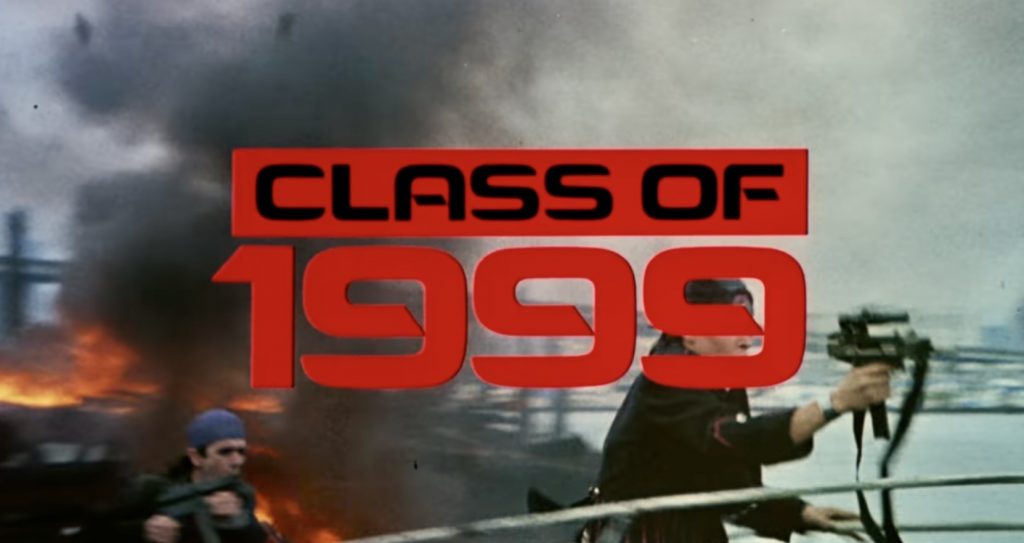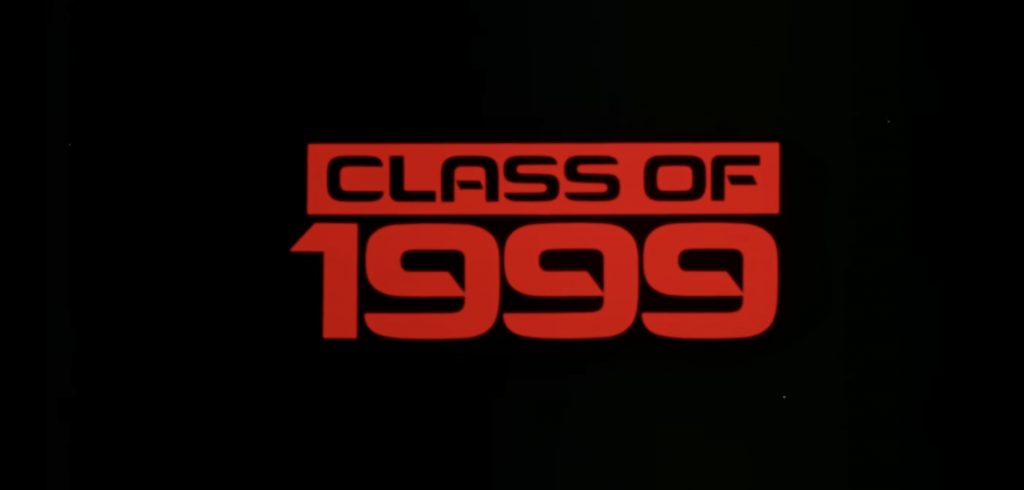Because of the largely unseen rise of guns and violence in schools, Class Of 1999 (1990) was an underrated movie for it’s time.
To begin, the movie Class Of 1999 takes place in the future, and it deals with guns and violence in Kennedy High, which has added sadistic robots as teachers. Moreover, it was filmed in Seattle, Washington. That being said, this flick’s main character is Culp, played by Bradley Gregg, with supporting characters in his gang, the Blackhearts. As well, this movie follows in the controversial footsteps of the movie Class Of 1984, which also dealt with school guns and violence in the future.
In the opening scene, Culp, leader of the Blackhearts, is released from jail. Culp is picked up from jail by the Blackhearts. In the reunion scene, we see Culp has changed; that is, he’s offered drugs by his gang, but he no longer wants to do drugs. Culp seems reserved and smarter. Plus, he’s figured out he’s a zero without an education.
Upon release back into society, Culp must report to school. However, the school resembles a prison, which has a harsh regime of reeducation for the “students”. Also, the school has barbed wire, guards, metal detectors, and a perimeter. The school easily resemble a warehouse, a holding cell, or concentration camp for gang members.
Gangs run the community outside the school. The Blackhearts are just one. The Razorheads are another gang. Without guns in the school, the gangs fight for territory in anyway they can. However, outside the school, these gangs are armed to the teeth with heavy artillery.
Meanwhile, sadistic robots act as teachers. They have “educational” directives. However, they have programming with underlying military functions. Due to glitches in the software, these robots revert back to their military function. They continue to reeducate the students, but the robots’ military applications start to resurface in the form of killing the enemy: The students.

As it turns out, the robots kill Culp’s brothers: Sonny and Angel. Immediately, Culp organizes the gangs and leads an attack on the robots. However, the robots are battle ready and war breaks out.
At times, this movie touches on class issues. Culp comes from the inner-city; furthermore, he comes from a poor family and lacks a real education; moreover, his mother is a drug addict and a single parent. However, Christie, Culp’s girlfriend and daughter of the principal of Kennedy High, comes from an upper-middle class family. We get to see class differences in terms of property and class values of the characters.
There is a secret underlying everything in this movie: The school, students, and robots are part of an experiment, which the principal has petitioned the military to complete in his school. The principal and military conduct an experiment in disciplinary education. Further, the students remain unaware as their status as human subjects.
Throughout the movie, we see civil rights violations. The students are not allowed to talk in class without permission, which infringes on their right to free speech. Students are searched without search warrants. Guards detained students without reason and patrol the parameter walls of the school. Also, teachers assault students for any arbitrary reason like administering illegal corporeal punishment or even murder. Plus, the students have not given their consent for being part of a military experiment or to be used as illegal human subjects. Civil rights violations speckle this movie.
Likewise, this movie resembles Class Of 1984 with it’s focus on guns and violence in schools. Class Of 1999 highlights guns and violence in schools. Similarly, Class Of 1984 highlighted guns and violence in schools. Now, guns and violence have become a reality in US schools; however, Class Of 1999 adds robots and AI into the future mix of guns and violence in US schools. Class Of 1999 is a follow up to issues raised about school guns and violence in the movie Class Of 1984.
After release of this movie in 1990, the Gun-Free Schools Act of 1994 (GFSA) was signed into law by President Bill Clinton. Also, the America’s Schools Act of 1994 (IASA) would be signed at around this time. These acts amended the Elementary and Secondary Education Act of 1965. The issue of guns and violence in schools was a live issue, which found it’s way into American movies.
Once again, one has to ask this question about this movie: Is this political propaganda created by Hollywood to shape the issue of guns in schools by the Democrats? Or is this another case of fiction mirroring reality when it comes to the issue of guns and violence in schools? One thing is for sure: There has been one school shooting for every week of this year on average.
Interestingly, in this movie, the gangs are segregated along racial lines. Culps gang is largely white males. The Razorbacks are largely middle eastern looking gangs. There seems to be an underlying racial component to this story.
Here again, fiction mirrors reality in racial segregation of society. The gangs are defacto segregated in their neighborhoods: Whites from one neighborhood and middle easterners from another neighborhood. Though segregation was outlawed decades ago, we still see segregation persist in this movie. Indeed, fiction mirrors reality in Class Of 1999.
Moreover, I can’t help think of Gramsci’s theory of Cultural Hegemony when watching this movie. Here, Gramsci said the ruling class would dominate a diverse society with a dominant ideology. In the movie, we see teachers pose dominant cultural values and mores while the gangs posses values and mores of the peasantry. Gramsci said the lower classes would eventually resist by creating their own academics and leaders.
Lastly, I liked Class Of 1999 for a few reasons. First, it’s a good science fiction movie to watch. Second, it dealt with controversial issues in an acceptable medium for the time. Finally, I liked the soundtrack.
